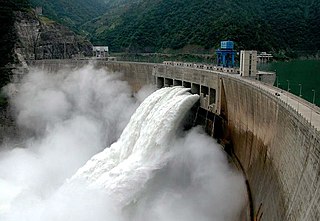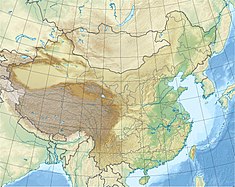Longtan Dam is a large roller-compacted concrete (RCC) gravity dam on the Hongshui River in Tian'e County of the Guangxi Zhuang Autonomous Region, China, a tributary of the Xi River and the Pearl River. The dam is 216.2 metres (709.3 ft) high and 849 m (2,785 ft) long; it is the tallest of its type in the world. The dam is intended for hydroelectric power production, flood control and navigation. The dam contains seven surface spillways, two bottom outlets and an underground power station. The Longtan ship lift, part of the dam complex, will be the tallest ship lift system in the world.

The Xiluodu Dam is an arch dam on the Jinsha River, i.e. the upper course of the Yangtze in China. It is located near the town of Xiluodu in Yongshan County of Yunnan Province but the dam straddles into Leibo County of Sichuan Province on the opposite side of the river. The primary purpose of the dam is hydroelectric power generation and its power station has an installed capacity of 13,860 MW. Additionally, the dam provides for flood control, silt control and its regulated water releases are intended to improve navigation downstream. Construction on the dam and power station began in 2005 and the first generator was commissioned in 2013, the last in 2014. It is operated by China Yangtze Power and is currently the fourth-largest power station in the world, as well as the fifth tallest dam world-wide.
The Xiaowan Dam is an arch dam on the Lancang (Mekong) River in Nanjian County, Yunnan Province in southwest China. The primary purpose of the dam is hydroelectric power generation and it supports a 4,200 MW power station. Constructed between 2002 and 2010 by Huaneng Power International at a cost of ¥32 billion, it is the world's second highest arch dam at 292 m (958 ft). It is also third highest among dams of all types behind Jinping-I and Nurek and the third largest hydroelectric power station in China.
The Guandi Dam is a gravity dam on the Yalong River, a tributary of the Yangtze River in Sichuan Province Southwest of China. It supplies water to four hydroelectric generators, each with generating capacity of 600 MW. The total generating capacity of the project is 2,400 MW. Construction started on October 20, 2010, with a ground-breaking ceremony. On February 9, 2012, the dam began to impound the reservoir and the last of the four generators were commissioned on 28 March 2013.
The Baihetan Dam is a large hydroelectric dam on the Jinsha River, an upper stretch of the Yangtze River in Sichuan and Yunnan provinces, in southwest China. The dam is a 289-meter-tall double-curvature arch dam with a crest elevation of 827 m, and a width of 72 m at the base and 13 m at the crest. It is considered to be the last large hydropower project in China after a series of projects starting with the Three Gorges Dam. It is also the second largest hydropower plant in the world. The hydropower station is equipped with 16 hydro-generating units that each have a capacity of 1 million kilowatts, making it the largest single-unit capacity globally. All hydro-generating units of the Baihetan hydropower station became fully operational on 20 December 2022.

The Ertan Dam is an arch dam on the Yalong River, a tributary of the Yangtze River in Sichuan Province, in southwest China.

The Yeywa Hydropower Station, located on the Myitnge River, 52 kilometres (32 mi) southeast of Mandalay city, at Yeywa village in Kyaukse Township, Mandalay Region in central Myanmar, is the country's first roller-compacted concrete (RCC) dam, and the site of a 790-megawatt (1,060,000 hp) hydroelectric power plant, the largest in the country.
The Dagangshan Dam is an arch dam on the Dadu River in Shimian County, Ya'an, Sichuan Province, China. The dam houses a hydroelectric power station with 4 x 650 MW generators for a total installed capacity of 2,600 MW. Construction on the dam began in 2008 and the power plant in 2010. The first two generators were commissioned on 2 September 2015, and the entire project was completed in 2016.
The Liyuan Dam is a concrete-face rock-fill dam on the Jinsha River on the border of Yulong County and Shangri-La County, Yunnan Province, China. The dam has an associated hydroelectric power station with a 2,400 MW power station containing 4 x 600 MW generators. Construction on the river diversion for the dam began in 2008. It began to impound its reservoir in November 2014 and on December 28, 2014 the first generator was commissioned. The second generator was commissioned in July 2015.
The Tingzikou Dam is a gravity dam on the Jialing River downstream of Guangyuan in Cangxi County, Sichuan province, China. The purposes of the dam is flood control, irrigation, hydroelectric power production and navigation. The dam supports a 1,100 MW power station and a 500-ton ship lift. The project was approved in October 2009 and after being shelved for 50 years. Construction began soon thereafter and the river was closed-off in January 2010. The dam began to impound its reservoir in May 2013 and the first generator went online in August. On 20 March 2014 the third generator was commissioned and the fourth and final on 29 April 2014.
The Jinping-I Dam also known as the Jinping-I Hydropower Station or Jinping 1st Cascade, is a tall arch dam on the Jinping Bend of the Yalong River in Liangshan, Sichuan, China. Construction on the project began in 2005 and was completed in 2014. Its power station has a 3,600 MW capacity to produce between 16 and 18 TW·h annually. Supplying the power station is a reservoir created by the 305-meter-tall arch dam, the tallest in the world. The project's objective is to supply energy for expanding industrialization and urbanization, improve flood protection, and prevent erosion.
The Longshou II Dam, also referred to as Longshou No. 2, is a concrete-face rock-fill dam on the Heihe River, located 35 km (22 mi) southwest of Zhangye in Gansu Province, China. It is part of the Gansu Heihe Rural Hydropower Development and supports a 157 MW power station. The dam's first feasibility study was carried out in 2000 and river diversion construction began in December 2001. In June 2002, the river was diverted and in September that year, filling of the dam's body began. On 17 August 2004, the first generator was operational with the rest by the end of the year. The 146.5 m (481 ft) high dam withholds a reservoir with a capacity of 86,200,000 m3 (69,883 acre⋅ft). It's spillway is located on the right bank and is a controlled chute type with a discharge capacity of 2,696 m3/s (95,208 cu ft/s). Water is delivered to the dam's power station downstream via a 1.7 km (1 mi) long tunnel. The dam is located upstream of the Longshou I Dam, an 80 m (262 ft) tall double-curvature arch dam with an installed capacity of 52 MW. Upstream is the Xiaogushan Dam, a gravity dam which diverts water to a 102 MW power station.
The Suofengying Dam is a concrete gravity dam on the Wu River, 44 km (27 mi) northwest of Guiyang in Guizhou Province, China. It is located 35.5 km (22 mi) downstream of the Dongfeng Dam and 74.9 km (47 mi) upstream of the Wujiangdu Dam. The primary purpose of the dam is hydroelectric power generation and it supports a 600 MW power station. Construction on the dam began on 26 July 2002 and on December 18 of that year, the river was diverted. Pouring of roller-compacted concrete into the dam's body began on 14 January 2004 and in June, the dam began to impound its reservoir. On 18 August, the first generator was operational and the last two in 2005. The 121.8 m (400 ft) tall dam creates a reservoir with a capacity of 201,200,000 m3 (163,115 acre⋅ft). The dam's power station is located on its right bank and contains three 200 MW Francis turbine-generators.

The Koldam Hydropower Station commonly known as Koldam, is an embankment dam on the Sutlej River upstream of the Dehar Power House. It is 18 km from Bilaspur off the Chandigarh-Manali Highway (NH-21) near Barmana, Himachal Pradesh, India. The main purpose of the dam is hydroelectric power generation and it will support an 800 MW power station. The dam was constructed by NTPC Limited.
The Gelantan Dam (戈兰滩大坝) is a gravity dam on the Lixian River, bordering the counties of Honghe and Jiangcheng in Yunnan Province, China. The primary purpose of the dam is hydroelectric power generation and it supports a 390 MW power station. Construction began in 2003, the river was diverted in 2006 and the first generator was commissioned in 2007, the last two in 2008. It is the sixth dam in the Lixian River cascade.
The Kajiwa Dam is a concrete-face rock-fill dam on the Muli River near Kajiwa in Muli Tibetan Autonomous County, Sichuan Province, China.
The Qiaoqi Dam is a rock-fill embankment dam on the Baoxinghe River in Baoxing County of Sichuan Province, China. The primary purpose of the dam is hydroelectric power generation. Construction on the project began in October 2002 and its 240 MW power station was commissioned in 2007. Water from the reservoir is diverted south to the power station via a 18.676 km (11.605 mi) long head-race tunnel and penstock. The power station is located on the north bank of the main stem Baoxing River. The drop in elevation between the reservoir and power station afford a hydraulic head of about 550 m (1,800 ft).
The Maoergai Dam is a rock-filled embankment dam on the Heishui River in Mao County of Sichuan Province, China. The primary purpose of the dam is hydroelectric power production and it supports a 420 MW power station. Preliminary construction for the dam began in 2006 while construction on the dam and power station commenced in 2008. The generators were commissioned in 2011. To produce power, water from the reservoir is diverted to a power station downstream through a 16.15 km (10.04 mi) long headrace tunnel and penstock. The difference in elevation between the reservoir and power station affords a hydraulic head of 168 m (551 ft). The dam sits just below the headwaters of the Heishui and water discharged through its power station regulates the flow of water for smaller power stations downstream.




